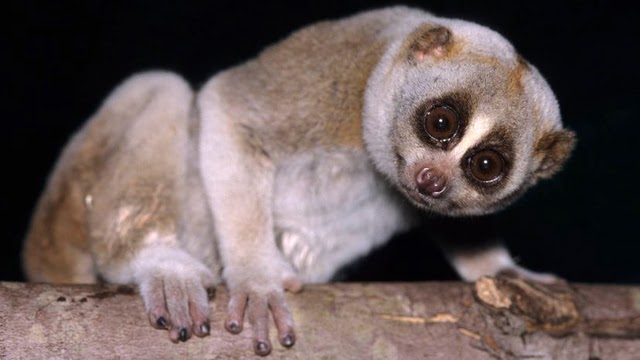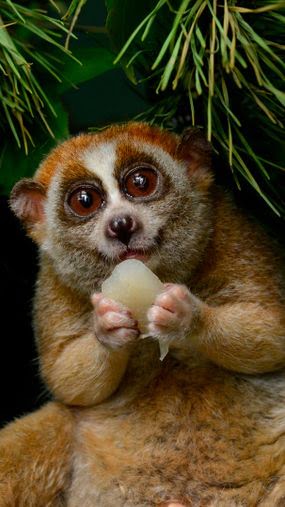Quck answer
The slow loris is a small, nocturnal primate native to Southeast Asia. Despite its cuddly appearance, it has a toxic bite that it uses for self-defense. The venom is produced by glands on the inside of the elbows, which the loris licks before biting. The venom can cause anaphylactic shock and even death in humans. The slow loris is also a victim of the illegal pet trade, as many people find them cute and desirable as pets. However, owning a slow loris as a pet is illegal in many countries and can have serious consequences for both the animal and the owner.
Wild Animals

The slow loris (Nycticebus bengalensis) has a charming appearance, but it also has a unique trait among primates and mammals: a toxic bite. These small creatures prefer to be alone and will bite when threatened by humans or other slow lorises, using their arms to raise and lick venom secreted from glands in their upper arm. The venom can cause tissue death or be fatal if not treated properly. Despite their size, slow lorises are fierce and shouldn’t be underestimated.
American zoologist Dean Conant Worcester described the slow loris in 1891 as having the “face of a bear, the hands of a monkey, [and] mov[ing] like a sloth.” The word “loris” comes from the Dutch word “loeris,” meaning clown, referring to the creature’s distinctive facial markings. Slow lorises have small ears, wide forward-facing eyes with rings around them, and a light-reflecting surface behind the retina, helping them see in the dark. They have solid bodies, dense fur, and only a stump of a tail. Their weight and length vary by species.
Slow Lorises Are Nocturnal
Slow lorises are found in Southeast Asia, including Vietnam, Cambodia, Laos, and China’s Yunnan province. They live in bamboo and hardwood forests and sleep during the day in crevices or hollows. They are nocturnal, opportunistic hunters, and use their sense of smell to hunt for insects and small prey, as well as eating fruit and tree gum. They lick dew off leaves for moisture.

An adult pygmy slow loris (Nycticebus pygmaeus) nibbling a frozen treat.
Duke Lemur Center
The Duke Lemur Center at Duke University in Durham, North Carolina, does not house lorises anymore, but Anna Lee, an education technician at the DLC, provides insight into slow loris behavior. When two lorises meet, they generally groom each other instead of fighting. In the wild, males and females may stay in the same space with their offspring, forming small family groups until the offspring disperse. These groups groom each other and sleep in contact with each other but often forage alone, and there is no clear dominance structure.
Jodi Stirk, an animal care technician who worked with slow lorises at the DLC, notes that these animals exhibit unique personalities, with some being shy or reserved while others are more outgoing and interactive with staff. Meanwhile, Dr. Anna Nekaris, a professor in primate conservation and anthropology at Oxford Brooks University, has studied slow lorises in the wild and found that they form strong family bonds. Breeding pairs in captivity, however, may not always be compatible, with some pairs being aggressive and potentially injuring each other. The biggest threats to slow lorises are habitat degradation and direct human interaction, such as hunting or attempts at domestication. All five species of slow loris are listed as vulnerable or endangered by the IUCN. The DLC stresses that slow lorises are not suitable as pets and are meant to live with other lorises in undisturbed rainforests. Social media videos of lorises being tickled or kept as pets do not tell the full story, as lorises taken from the wild often have their teeth removed and exhibit arm-raising behavior as a defensive posture.
Fascinating Things to Know
The Oxford Brooks University’s Nocturnal Primate Research Group is focused on researching all types of slender and slow lorises found in Asia. Due to the significant reduction in the habitat of lorises on the Indonesian island of Java, up to 90%, the group is constructing and installing bridges for lorises. These bridges are made using irrigation tubing, and they connect different locations in the treetops to prevent lorises from being isolated from their natural habitats.
FAQ
1. What is a slow loris?
A slow loris is a small, nocturnal primate that is native to Southeast Asia. They are known for their big, round eyes and cute appearance, which has made them popular as pets. However, they are also known for their toxic bite, which can cause serious harm to humans.
2. How does a slow loris use its toxic bite?
A slow loris uses its toxic bite as a defense mechanism. It secretes a toxic substance from glands located on the inside of its elbows, which it can then transfer to its mouth. When threatened, the slow loris will lick the toxin onto its teeth, and then bite its attacker. The toxin can cause swelling, pain, and even anaphylactic shock in some cases.
3. Why are slow lorises popular as pets?
Slow lorises are popular as pets because of their cute appearance and docile demeanor. However, they are actually very unsuitable as pets. They require specialized diets and environments, and their toxic bite can be dangerous to humans. Additionally, many of the slow lorises sold as pets are illegally captured from the wild, which is causing their populations to decline.
4. Are slow lorises endangered?
Yes, all species of slow lorises are considered to be endangered or critically endangered. Their populations have declined significantly due to habitat loss, hunting for the pet trade, and use in traditional medicine. Additionally, slow lorises have a low reproductive rate, which makes it difficult for their populations to recover once they have been depleted.
5. What is the lifespan of a slow loris?
The lifespan of a slow loris is typically around 20 years in captivity, although their lifespan in the wild is not well-known. They reach sexual maturity at around 18 months of age, and females typically give birth to one or two offspring per year.
6. What do slow lorises eat?
Slow lorises are omnivores, which means they eat both plants and animals. Their diet varies depending on their habitat and the season, but typically includes insects, fruit, tree sap, and small vertebrates such as lizards and birds.
7. How are slow lorises being protected?
Slow lorises are being protected through a combination of conservation efforts, including habitat preservation, education, and law enforcement. In many countries, it is illegal to capture or trade slow lorises, and penalties for doing so have been increased. Additionally, organizations are working to raise awareness about the dangers of keeping slow lorises as pets, and to promote responsible tourism that supports conservation efforts.
8. Can slow lorises be kept as pets?
No, slow lorises should not be kept as pets. They are wild animals that require specialized care, and their toxic bite can be dangerous to humans. Additionally, many of the slow lorises sold as pets are illegally captured from the wild, which is causing their populations to decline.
9. What can I do to help protect slow lorises?
You can help protect slow lorises by supporting conservation organizations that work to preserve their habitats and raise awareness about the dangers of the pet trade. You can also avoid products that contain slow loris parts, such as traditional medicines or exotic foods. Finally, you can spread the word about the importance of protecting slow lorises, and encourage others to do the same.





Leave a Reply